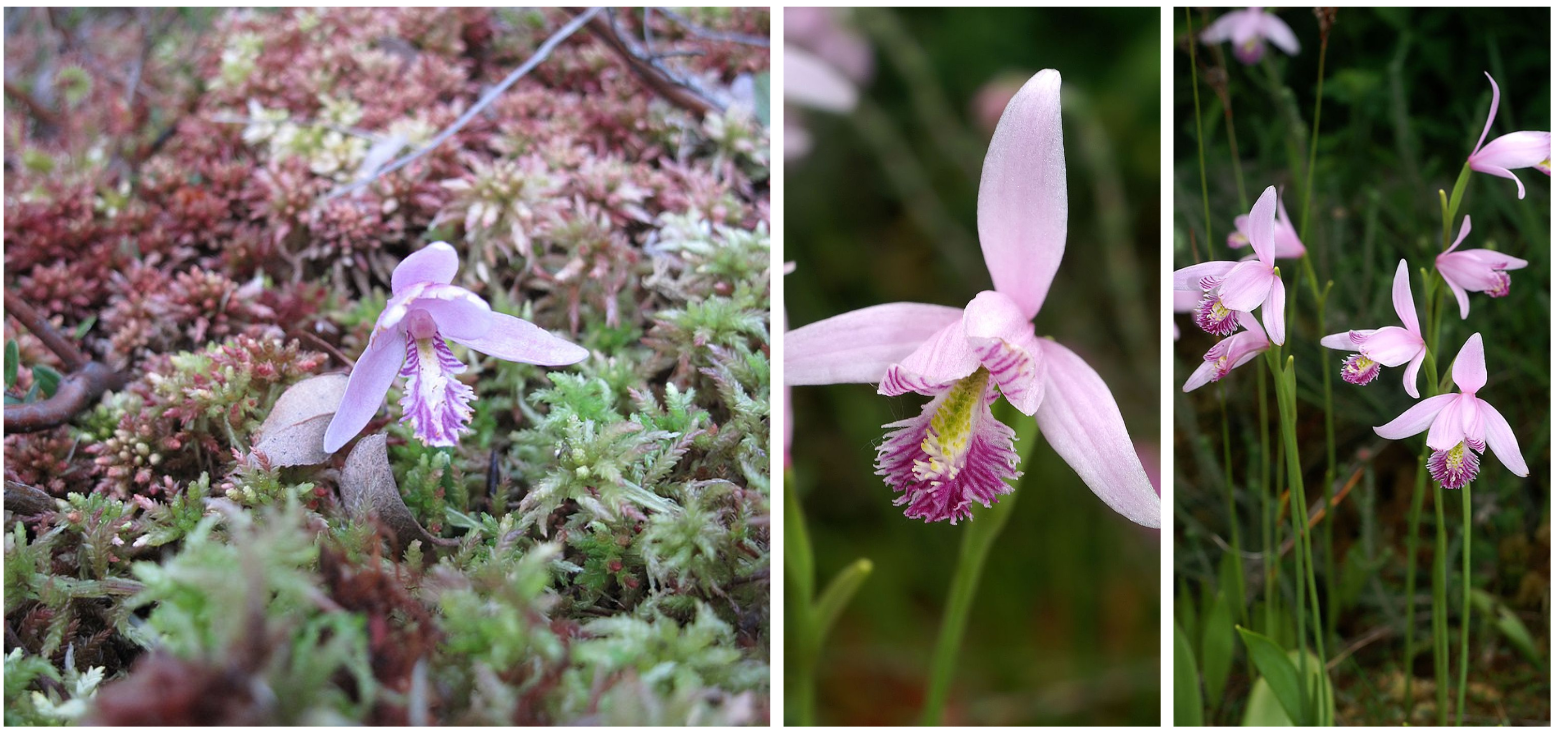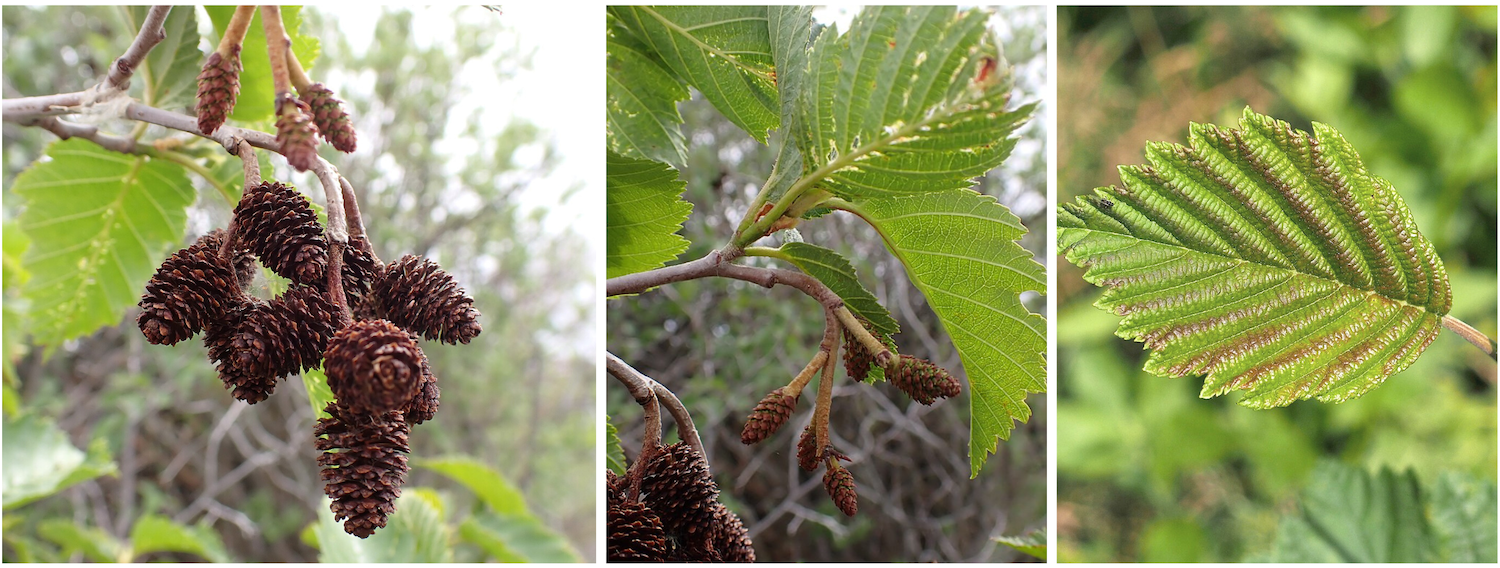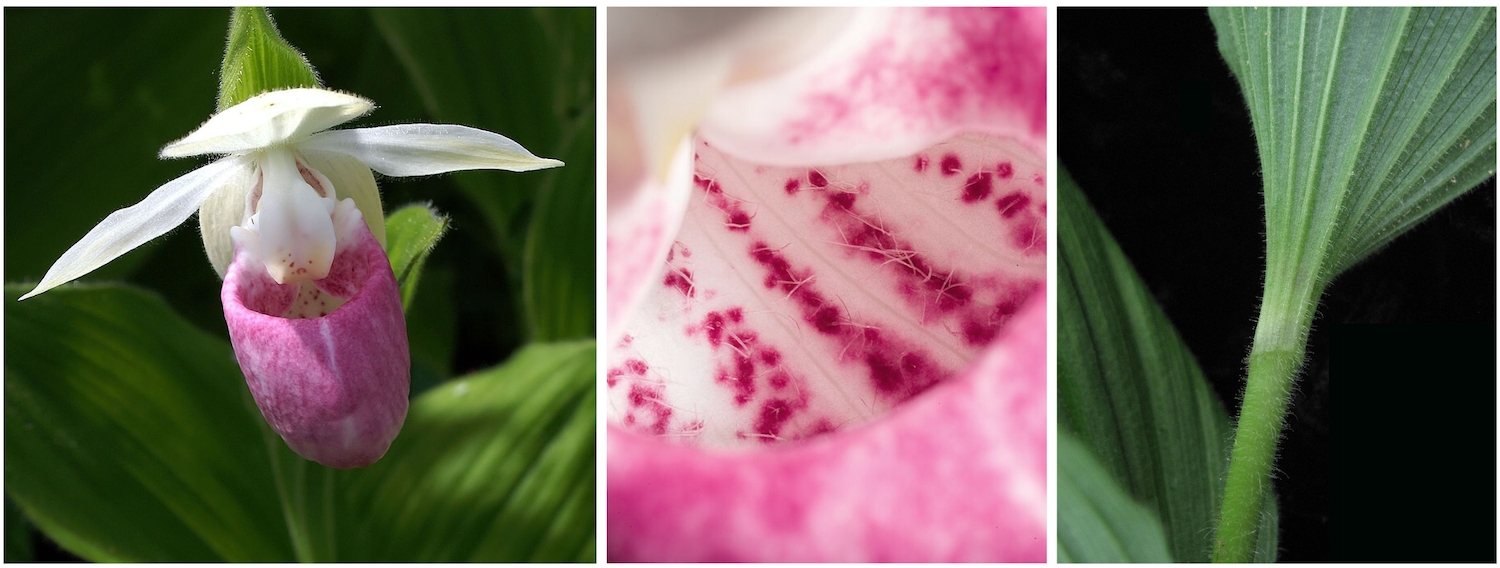Today is World Wetlands Day! To celebrate, this post showcases some of the diverse plant life living within Atlantic Canada’s wetlands. From putrid defrosters to predatory bog dwellers, to gorgeous orchids and dune-constructing grasses, you’ll be surprised at what you can find in wetlands.
What Are Wetlands?
Wetlands are areas of land that are saturated with water, either permanently or seasonally. Canada is home to 25 percent of the world’s wetlands!1 These unique ecosystems are some of the most productive environments in the world. In Atlantic Canada, wetlands are broken down into two types: inland and coastal wetlands


Inland Wetlands
Inland wetlands are freshwater wetlands. They consist of peatlands (bogs and fens), marshes, and forested wetlands.2 They host an array of wildlife and are recognizable by their abundance of water-loving plants.
Peatlands
Peatlands are areas of land characterized by the accumulation of peat. Peat is a type of soil consisting of partially decayed plant material, primarily mosses, that accumulates in waterlogged environments such as bogs and fens.
The waterlogged conditions of peatlands is what inhibits the full decomposition of plant material. As the growth of organic matter outpaces decomposition, it leads to the accumulation of peat.3 In cool climate regions, sphagnum mosses, sedges, and shrubs make up much of the vegetation in peatlands.3
There are two subtypes of peatlands: bogs and fens. Bogs form when prehistoric lakes are slowly filled in by plant debris.2 These wetlands are nutrient poor and acidic, which means plants must get most of their nutrients from rainwater. Fens, on the other hand, are nutrient rich young bogs. They get their nutrients from rainwater and groundwater.2 Fens are more biologically diverse, often home to rare and endangered species.
Sphagnum Moss

Sphagnum moss thrives in bogs and fens. It is typically green, but can also be red or brown. The moss forms dense mats on the surface of bogs and can be several feet thick.
Sphagnum moss is a non-vascular plant, meaning it lacks a specialized system of vessels for the transport of water and nutrients. Instead, it absorbs water and nutrients through its surface. In fact, sphagnum earns recognition for its remarkable water retention ability. It can hold up to 20 times its own weight in water!4
Sphagnum peat moss is a widely-used soil amendment. In recent years, peat moss extraction has been a subject of concern, as it leads to the destruction of peatlands and the release of stored carbon into the atmosphere.
Rose Pogonia (Pogonia ophioglossoides)

Rose pogonia or snakemouth orchid (Pogonia ophioglossoides) is a perennial herb native to North America. It is found in moist, acidic soils, like those of bogs and fens.
Rose pogonia is a member of the orchid family (Orchidaceae). It has a pink flower with a distinctive snake-like lip and a narrow and lanceolated leaf mid-way up the stem. The plant spreads quickly through above ground runners and flowers in late spring and summer. The flowers have a sweet and fragrant smell that attracts bees.
Northern Pitcher Plant

The northern pitcher plant (Sarracenia purpurea) is a carnivorous plant that lives in nutrient-poor peatlands. Its trumpet-shaped leaves make it easy to identify. They are a deep maroon or green colour. The plant produces small downward-facing flowers in the spring.
To survive in nutrient-poor soils, the northern pitcher plant has developed the ability to capture and digest insects and salamanders.5 The leaves of the plant form a deep pitcher that has slippery walls and contains water and digestive enzymes. The plant’s colour, scent, and nectar-producing glands (extrafloral nectaries) attract prey into the pitcher. While many are able to escape, the ones who remain provide the plant with the necessary nutrients to survive.
Some animals can survive the plant’s digestive enzymes! The northern pitcher plant host several anthropod species (Metriocnemus knabi, Wyeomyia smithii) who feed on the flower’s victims.6
Round-Leaved Sundew (Drosera rotundifolia)

Round-leaved sundew (Drosera rotundifolia) is another carnivorous plant found in bogs, fens, and wet meadows. Bright red glandular hairs cover the plant’s round leaves and release a sticky mucilage to trap insects. When the plant detects prey, it shuts its leaves on the unknowing victim who is slowly digested.
Round-leaved sundew produces small, white, five-petaled flowers on a tall, thin stem. They are dainty flowers that seem out of place for such a formidable plant.
Marshes
Marshes are emergent wetlands marked by saturated soils and an abundance of water-loving plants such as cattails, grasses, rushes, and water lilies.2 They usually occupy low-lying regions close to rivers, lakes, or coasts and can be freshwater or saltwater, tidal or non-tidal.2 Freshwater marshes can host the following plants:
Blue Flag Iris (Iris versicolor)

The blue flag iris (Iris versicolor) thrives in marshes and bogs near streams and rivers. It is recognizable for its striking blue flowers that bloom in spring and early summer. The flowers have three petals, with the lower petal being the largest and most showy. The leaves of the plant are long, narrow, and sword-shaped, and can grow up to 2 feet tall. This showy plant attracts bees, hummingbirds, and moths.
Pickerelweed (Pontederia cordata)

Pickerelweed (Pontederia cordata) is a perennial aquatic plant. Marshes, swamps, and the edges of ponds and streams are its common habitats. The plant can grow up to 4 feet tall and has large, striking blue-violet flowers that bloom in the summer.
Pickerelweed plays an important role in the wetland ecosystem as food and cover for wildlife. Waterfowl, geese, white-tailed deer, and muskrats all eat the plant on occasion.7 Fish, birds, and small mammals often hide in its foliage, while bees and ruby-throated hummingbirds pollinate it.7
Cattails (Typha species)

Cattails grow in abundance in marshes and along the edges of ponds and lakes. Two common species in Atlantic Canada’s wetlands are Typha latifolia and T. angustifolia. These plants have long, flat leaves that can grow up to 6 feet tall. At the top of the plant, a sausage-shaped spike contains the flowers and seeds. Cattails grow in dense stands and reproduce via seeds and spreading rhizomes. To prevent overpopulation, they can produce a toxin that prevents their own seeds from germinating!8
Cattails are a valuable resource for wildlife, providing food and habitat for a variety of animals such as mallards, Canada geese, frogs, and salamanders.8 I associate cattail strands with red-winged blackbirds who nest in them and perch on top of their flower heads.
Indigenous peoples of Canada use cattail to weave baskets, mats, bags, and tents.9 Many cultures have used the plant as food. You can grind the roots into flour, boil the shoots, and add the protein-rich pollen to foods.10
Forested Wetlands
Forested wetlands are distinguished by the presence of trees and other woody vegetation. Cedar, tamarack, black spruce, maples, willow, dogwood, and alder grow in the waterlogged soil conditions found in this habitat.
Forested wetlands boast high levels of biodiversity, including rare and endangered species.11 In North America, they are home to many species of migratory birds, such as the wood duck and the prothonotary warbler.
Skunk Cabbage (Symplocarpus foetidus)

Skunk cabbage (Symplocarpus foetidus) grows in forested wetlands and damp meadows. It is one of the first plants to sprout in the spring. It actually melts its way through the snow in a chemical process which can heat the flower to 15°C!12
The spathe (a modified leaf surrounding the flower spike) emerges first and is a deep purple colour, sometimes green or speckled with green. The spathe shelters a flower spike, which is covered in tiny flowers. The plant’s leaves emerge later in the spring.
Skunk cabbage gets its name from the putrid smell it emits. This unpleasant odour attracts pollinators like flies and carrion beetles.
Speckled Alder (Alnus incana subsp. rugosa)

Speckled alder (Alnus incana) is a deciduous shrub or small tree common in forested wetlands. The shrub grows up to 30 feet and is recognizable by its smooth, brown-grey bark. Tiny pores, called lenticels, cover the bark and their speckled appearance is where this shrub gets its common name.
Alnus incana is a nitrogen-fixer and surrounding trees benefit from its presence. Deer and moose browse the plant and many wildlife take cover in its dense thickets.
Black Spruce (Picea mariana)

Black spruce (Picea mariana) is the provincial tree of Newfoundland and Labrador. It grows in cold, poorly drained sites with acidic soil. This spruce is a slow-grower and reaches heights of around 50 feet. The bark is thin and scaly, and the leaves are needle-like and blue-green in colour. It has very shallow roots making it susceptible to wind damage.
Black spruce is one of the most widely distributed trees in Canada. It stretches from Newfoundland to British Columbia and up into the territories. It’s an important plant in many forest ecosystems, providing habitat and food for a variety of wildlife, including moose, grouse, red squirrels, mice, voles, and snowshoe hare.13 Ruby-crowned kinglets and palm warblers nest in black spruce, and caribou and white-tailed deer use it as thermal cover in winter when snow covers its boughs.13
Showy Lady’s Slipper (Cypripedium reginae)

Cypripedium reginae, known as showy lady’s slipper, is a rare perennial wildflower that is native to northern North America. It is a member of the orchid family and is known for its large, showy flowers that are pink and white. The flowers have a distinctive shape, with a large, pink pouch-like lip (labellum).
Showy lady’s slipper grows in moist, shady woodlands and blooms in late spring or early summer. In many areas, habitat loss, contaminated water sources, and over-collecting threaten it.14 Count yourself lucky should you ever come across one!
Coastal Wetlands
Coastal wetlands are marked by their proximity to the ocean. They are constantly changing thanks to the tides, but are protected from the ocean surf.2 Atlantic Canada is home to many salt marshes. They are found in the upper intertidal zone, the region of the shoreline covered by water only during the highest tides.
The plants that live in the intertidal zone have adapted to the harsh conditions of salt or brackish water. They also have to withstand regular exposure to the sun, and variations in temperature and salinity.
Marram Grass (Ammophila breviligulata)

Marram grasses play an important role in the formation and stabilization of sand dunes. They have deep roots that help to bind the sand and prevent erosion, thus protecting salt marshes from the powerful ocean surf. Marram grass spreads quickly and densely through specialized roots called rhizomes that grow vertically and horizontally. The plant is commonly used for beach restoration projects.
Sea Milkweed (Lysimachia maritima)

You can find sea milkweed (Lysimachia maritima) growing in sandy or rocky areas and in salt marshes and flats. The plant can form dense mats of foliage as it creeps along the earth. The leaves of sea milkweed are fleshy and have a glossy green colour. They store fresh water to help the plant survive in salty and sandy conditions.15 The flowers are a mix of pink, magenta, and white.
Saltmarsh Goldenrod (Solidago sempervirens)

Saltmarsh goldenrod (Solidago sempervirens) grows in sandy soils along the coasts of the Atlantic Ocean. The plant can reach up to 4 feet tall. It has narrow, lanceolate, toothless, and hairless leaves that are bright green in colour. The flowers are small and yellow, and they bloom in large clusters at the top of the stems in late summer and early fall.
Saltmarsh goldenrod supports a variety of insects and the foliage provides important nesting habitat and cover for some species of bird, including willets, killdeer, and piping plovers.16 Migrating monarchs use the plant as a source of nectar in the fall.16
Ecological Importance and Threats to Wetlands
Along with the diverse plant life they support, there’s so much to celebrate about Atlantic Canada’s wetlands. Wetlands provide flood control, carbon sequestration, drought protection, and habitat for wildlife. They are capable of filtering pollutants from waters destined for our lakes, rivers, and drinking water. Wetlands actually store twice as much carbon as the world’s forests!17
Unfortunately, wetlands are often viewed negatively as an impedement to development and agriculture or as bug-filled nuisances with little recreational value. Indeed, human activities are threatening our remaining wetlands and the plants that inhabit them. Already, we’ve lost 70% of Canada’s wetlands in settled areas.18 In the Bay of Fundy, we’ve lost 80% of our coastal wetlands!19 Pollution, development, and climate change are among top concerns. To save wetlands, we must first change public perception of them.
World Wetlands Day
World Wetlands Day is an opportunity to raise awareness about wetlands and the important ecological services they provide. You can celebrate World Wetlands Day by visiting a wetland near you, attending a local event, or sharing information about wetlands with family and friends. You can also support organizations that work to protect wetlands and their associated wildlife. I hope this post gave you a new or renewed appreciation for Atlantic Canada’s wetlands and the species that inhabit them.
If you are looking for more information on wetlands and World Wetlands Day, you can visit the Ramsar Convention on Wetlands website. The Ramsar Convention is an intergovernmental treaty that promotes the conservation and wise use of wetlands around the world.
Drop me a line in the comments section and tell me your favourite wetland or wetland species!
Other Posts That You Might Like
Sand Dunes: Their Ecological Importance
Tree Lungwort (Lobaria pulmonaria)
Monarchs: Resilience in the Face of Fragility and Adversity
Sources
1 Nature Conservancy Canada. “Wetlands of Atlantic Canada.”
2 Wildlife Habitat Canada. “A Practical Guide to the Importance of New Brunswick’s Wetlands.”
3 International Peatland Society. “What Are Peatlands?“
4 Irish Peatland Conservation Council. “Sphagnum Moss – the Bog Builder.”
5 Carly Cassella. 2019. “Grisly Discovery in Canada Reveals Pitcher Plants Aren’t Just Eating Bugs.” Science Alert.
6 Adirondaks Forever Wild. “Pitcher Plant (Sarracenia purpurea).”
7 Adirondaks Forever Wild. “Pickerelweed (Pontederia cordata).”
8 “Wetland Producers.” Nature.org
9 Sierra Club BC. “Cattail.”
10 Amber Kanuckle. 2021. “The Many Uses for Wild, Edible Cattails.” Farmer’s Almanac.
11 Karen Harper. 2021. “Understanding Patterns of Biodiversity and Ecosystem Functioning of Forested Wetlands in Atlantic Canada: Implications for Conservation.” Canadian Journal of Forest Research.
12 Lady Bird Johnson Wildflower Centre. “Symplocarpus foetidus.“
13 Nature Conservancy Canada. “Black Spruce.”
14 Wayne Owen. “Showy Lady’s Slipper (Cypripedium reginae).”
15 Daniel Mosquin. 2014. “Lysimachia maritima.” UBC Botanical Garden.
16 United States Department of Agriculture. “Monarch Germplash Seaside Goldenrod.”
17 United Nations Environment Programme. “Peatlands Store Twice as Much Carbon As All the World’s Forests.”
18 Ducks Unlimited Canada. “Wetlands.“
19 Moira Donovan. 2022. “‘Swamp as Sacred Space’: Save Wetlands to Save Ourselves, Say Experts.” CBC.
Images in order of appearance:
Images are all found via Wikimedia Commons. Links to licensing: CC BY 4.0, CC BY-SA 3.0, CC0, CC BY-SA 2.0, Public Domain
Sphagnum moss: Kjell Ivar Flatberg, NTNU Vitenskapsmuseet, CC BY 4.0 / Bernd Haynold, CC BY-SA 3.0 / HermannSchachner, CC0
Rose pagonia: Laval University, CC BY-SA 4.0 / Orchi, CC BY-SA 3.0 / Orchi, CC BY-SA 3.0
Northern pitcher plant: David J. Stang, CC BY-SA 4.0 / Clump, CC0 / Averater, CC BY-SA 3.0
Round-leaved sundew: Ryzhkov Sergey, CC BY-SA 3.0 / Aurelijus Banelis, CC BY-SA 4.0 / Mike Pennington, CC BY-SA 2.0
Blue flag iris: Ryan Hodnett, CC BY-SA 4.0 / Laval University, CC BY-SA 4.0
Pickerel weed: Cephas, CC BY-SA 3.0 / Krzysztof Ziarnek, Kenraiz, CC BY-SA 4.0 / Sixflashphoto, CC BY-SA 4.0
Cattail: Paul Harrison, CC BY-SA 4.0 / Krzysztof Ziarnek, Kenraiz, CC BY-SA 4.0 / Photo by David J. Stang, CC BY-SA 4.0
Skunk cabbage: Cephas, CC BY-SA 4.0 / USGS Bee Inventory and Monitoring Lab from Beltsville, Public domain / Alpsdake, Public domain
Speckled alder: Matt Lavin, CC BY-SA 2.0 / Matt Lavin, CC BY-SA 2.0 / Hladac, CC BY-SA 4.0
Black spruce: Cephas, CC BY-SA 4.0 / Iifar, Public domain / Arthur Chapman, CC BY 2.0
Show lady’s slipper: Orchi, CC BY-SA 3.0 / sunoochi from Sapporo, Hokkaido, Japan, CC BY 2.0 / Laval University, CC BY-SA 4.0
Marram grass: Royalbroil, CC BY-SA 3.0 / Jenna Amirault (author’s image)
Sea milkweed: Arnstein Rønning, CC BY-SA 3.0 / Yurii Basov, CC0 / Christian Fischer, CC BY-SA 3.0
Seaside goldenrod: Sam Fraser-Smith from Brisbane, Australia, CC BY 2.0